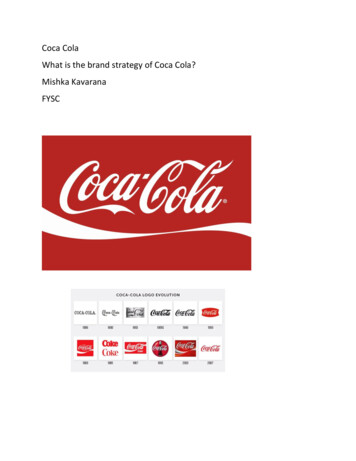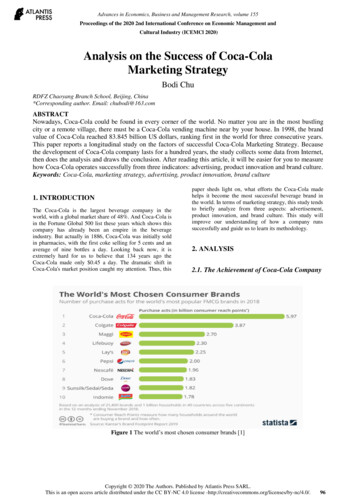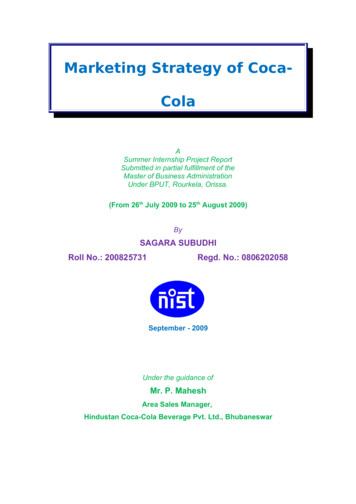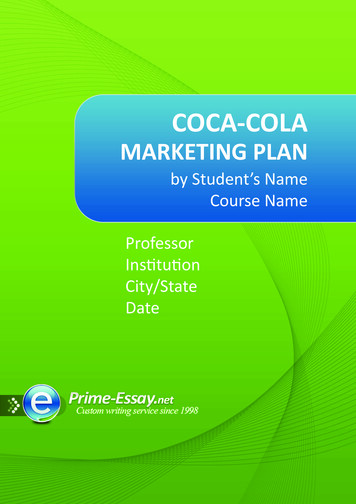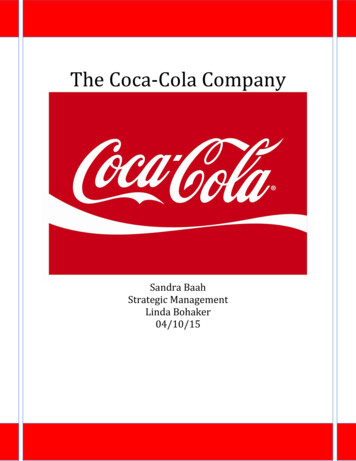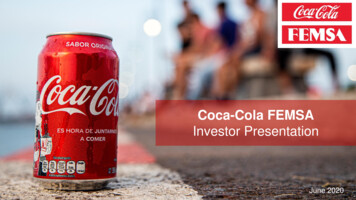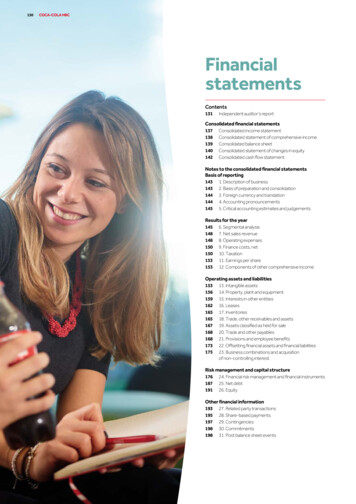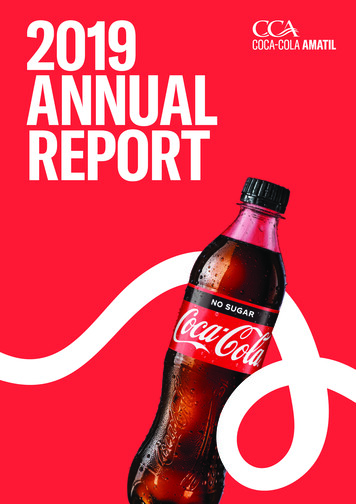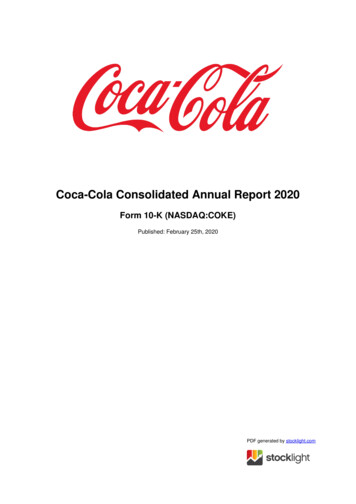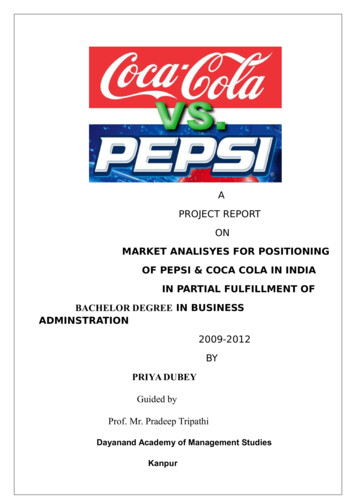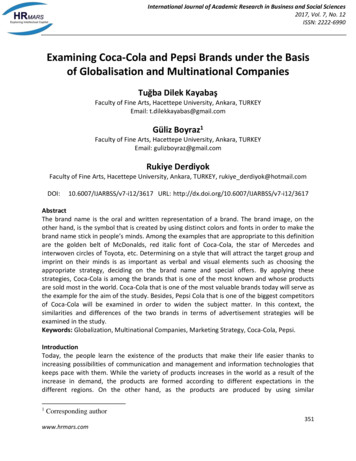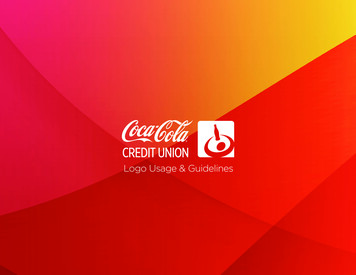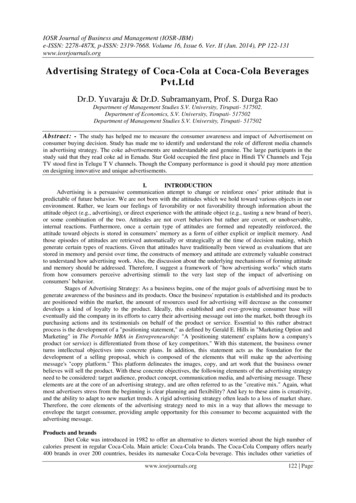
Transcription
IOSR Journal of Business and Management (IOSR-JBM)e-ISSN: 2278-487X, p-ISSN: 2319-7668. Volume 16, Issue 6. Ver. II (Jun. 2014), PP 122-131www.iosrjournals.orgAdvertising Strategy of Coca-Cola at Coca-Cola BeveragesPvt.LtdDr.D. Yuvaraju & Dr.D. Subramanyam, Prof. S. Durga RaoDepartment of Management Studies S.V. University, Tirupati- 517502.Department of Economics, S.V. University, Tirupati- 517502Department of Management Studies S.V. University, Tirupati- 517502Abstract: - The study has helped me to measure the consumer awareness and impact of Advertisement onconsumer buying decision. Study has made me to identify and understand the role of different media channelsin advertising strategy. The coke advertisements are understandable and genuine. The large participants in thestudy said that they read coke ad in Eenadu. Star Gold occupied the first place in Hindi TV Channels and TejaTV stood first in Telugu T V channels. Though the Company performance is good it should pay more attentionon designing innovative and unique advertisements.I.INTRODUCTIONAdvertising is a persuasive communication attempt to change or reinforce ones’ prior attitude that ispredictable of future behavior. We are not born with the attitudes which we hold toward various objects in ourenvironment. Rather, we learn our feelings of favorability or not favorability through information about theattitude object (e.g., advertising), or direct experience with the attitude object (e.g., tasting a new brand of beer),or some combination of the two. Attitudes are not overt behaviors but rather are covert, or unobservable,internal reactions. Furthermore, once a certain type of attitudes are formed and repeatedly reinforced, theattitude toward objects is stored in consumers’ memory as a form of either explicit or implicit memory. Andthose episodes of attitudes are retrieved automatically or strategically at the time of decision making, whichgenerate certain types of reactions. Given that attitudes have traditionally been viewed as evaluations that arestored in memory and persist over time, the constructs of memory and attitude are extremely valuable constructto understand how advertising work. Also, the discussion about the underlying mechanisms of forming attitudeand memory should be addressed. Therefore, I suggest a framework of "how advertising works" which startsfrom how consumers perceive advertising stimuli to the very last step of the impact of advertising onconsumers’ behavior.Stages of Advertising Strategy: As a business begins, one of the major goals of advertising must be togenerate awareness of the business and its products. Once the business' reputation is established and its productsare positioned within the market, the amount of resources used for advertising will decrease as the consumerdevelops a kind of loyalty to the product. Ideally, this established and ever-growing consumer base willeventually aid the company in its efforts to carry their advertising message out into the market, both through itspurchasing actions and its testimonials on behalf of the product or service. Essential to this rather abstractprocess is the development of a "positioning statement," as defined by Gerald E. Hills in "Marketing Option andMarketing" in The Portable MBA in Entrepreneurship: "A 'positioning statement' explains how a company'sproduct (or service) is differentiated from those of key competitors." With this statement, the business ownerturns intellectual objectives into concrete plans. In addition, this statement acts as the foundation for thedevelopment of a selling proposal, which is composed of the elements that will make up the advertisingmessage's "copy platform." This platform delineates the images, copy, and art work that the business ownerbelieves will sell the product. With these concrete objectives, the following elements of the advertising strategyneed to be considered: target audience, product concept, communication media, and advertising message. Theseelements are at the core of an advertising strategy, and are often referred to as the "creative mix." Again, whatmost advertisers stress from the beginning is clear planning and flexibility? And key to these aims is creativity,and the ability to adapt to new market trends. A rigid advertising strategy often leads to a loss of market share.Therefore, the core elements of the advertising strategy need to mix in a way that allows the message toenvelope the target consumer, providing ample opportunity for this consumer to become acquainted with theadvertising message.Products and brandsDiet Coke was introduced in 1982 to offer an alternative to dieters worried about the high number ofcalories present in regular Coca-Cola. Main article: Coca-Cola brands. The Coca-Cola Company offers nearly400 brands in over 200 countries, besides its namesake Coca-Cola beverage. This includes other varieties ofwww.iosrjournals.org122 Page
Advertising Strategy of Coca -Cola at Coca-Cola Beverages Pvt.LtdCoca-Cola such as: Diet Coke (introduced in 1982), which uses aspartame, a synthetic phenylalanine-basedsweetener in place of sugar ,Diet Coke Caffeine-Free, Cherry Coke (1985) , Diet Cherry Coke (1986),Coke withLemon (2001) ,Diet Coke with Lemon (2001) ,Vanilla Coke (2002),Diet Vanilla Coke (2002) ,Coca-Cola C2(2004) ,Coke with Lime (2004),Diet Coke with Lime (2004),Diet Coke Sweetened with Splenda (2005),CocaCola Zero (2005),Coca-Cola Black Cherry Vanilla (2006),Diet Coca-Cola Black Cherry Vanilla (2006) ,CocaCola Black (2006),Diet Coke Plus (2007) ,Coca-Cola Orange (2007) ,Summer Of US Coke Range (2007-2008)Growth Rate of Coca-Cola in India: Coca Cola posted 8 per cent volume growth in the October-Decemberquarter in India but its business in the country was slower during 2013 than in recent years amidst slowingeconomic environment. The Atlanta-based company that posted a net income of USD 1.7 billion during thefourth quarter, down 8 per cent from USD 1.86 billion in the year-ago period, said India, China and Japan ledthe firm's volume growth in its Pacific group. "Our Pacific Group's volume grew 4 per cent in the quarter,representing a sequential improvement versus the third quarter year-to-date results. Growth was broad basedwith 8 per cent growth in India, 5 per cent growth in China and 3 per cent growth in Japan," it said in astatement. This marked Coca-Cola India's 30th consecutive quarter of growth, 19 of which are double digits.Coca Cola's overall net operating revenues were down 4 per cent to USD 11.040 billion from USD 11.455billion in the fourth quarter. Its Bottling Investments Group's (BIG) volume grew 7 per cent in the quarter on acomparable basis, led by Germany, China and India, after adjusting for the net impact of structural changes,primarily the deconsolidation of the Philippine and Brazilian bottling operations in 2013. The slowdown in theIndian economy, however, had its impact on its volume sales on a yearly basis. "Our China and India businessesboth grew slower than in recent years amidst slowing economic environments, but saw stronger performance inthe second half of the year due to a focus on execution and normalized weather," the company said. The CocaCola Company Chairman and Chief Executive Officer Muhtar Kent said: "2013 was marked by ongoing globalmacroeconomic challenges in many markets around the world. And while our business was not immune to thesepressures leading to moderated global volume growth, we delivered sound financial results in line with ourlong-term profit targets." The company gained global value share in total non- alcoholic ready-to-drinkbeverages as well as global volume and value share in core sparkling and still beverages for the year, he added.On the outlook, Kent said: "A rising middle class, greater urbanization and increasing personalconsumption expenditures in markets around the world will continue to drive greater demand for our beveragesas consumers look for moments of refreshment. As we work to restore momentum in our business during 2014,we see many reasons to believe we can accelerate our growth." Coca Cola further said it expects to save USD1 billion through its productivity enhancement by 2016 that will be redirected primarily into increased mediainvestments such as advertising. The Atlanta-based company that posted a net income of USD 1.7 billionduring the fourth quarter, down 8 per cent from USD 1.86 billion in the year-ago period, said India, China andJapan led the firm's volume growth in its Pacific group. "Our Pacific Group's volume grew 4 per cent in thequarter, representing a sequential improvement versus the third quarter year-to-date results. Growth was broadbased with 8 per cent growth in India, 5 per cent growth in China and 3 per cent growth in Japan," it said in astatement. This marked Coca-Cola India's 30th consecutive quarter of growth, 19 of which are double digits.Coca Cola's overall net operating revenues were down 4 per cent to USD 11.040 billion from USD 11.455billion in the fourth quarter. Its Bottling Investments Group's (BIG) volume grew 7 per cent in the quarter on acomparable basis, led by Germany, China and India, after adjusting for the net impact of structural changes,primarily the deconsolidation of the Philippine and Brazilian bottling operations in 2013. The slowdown in theIndian economy, however, had its impact on its volume sales on a yearly basis."Our China and India businessesboth grew slower than in recent years amidst slowing economic environments, but saw stronger performance inthe second half of the year due to a focus on execution and normalized weather," the company said. The CocaCola Company Chairman and Chief Executive Officer Muhtar Kent said: "2013 was marked by ongoing globalmacroeconomic challenges in many markets around the world. And while our business was not immune to thesepressures leading to moderated global volume growth, we delivered sound financial results in line with ourlong-term profit targets." The company gained global value share in total non- alcoholic ready-to-drinkbeverages as well as global volume and value share in core sparkling and still beverages for the year, he added.On the outlook, Kent said: "A rising middle class, greater urbanization and increasing personal consumptionexpenditures in markets around the world will continue to drive greater demand for our beverages as consumerslook for moments of refreshment. As we work to restore momentum in our business during 2014, we see manyreasons to believe we can accelerate our growth." Coca Cola further said it expects to save USD 1 billionthrough its productivity enhancement by 2016 that will be redirected primarily into increased media investmentssuch as advertising. Its Bottling Investments Group's (BIG) volume grew 7 per cent in the quarter on acomparable basis, led by Germany, China and India, after adjusting for the net impact of structural changes,primarily the deconsolidation of the Philippine and Brazilian bottling operations in 2013. The slowdown in theIndian economy, however, had its impact on its volume sales on a yearly basis. "Our China and India businesseswww.iosrjournals.org123 Page
Advertising Strategy of Coca -Cola at Coca-Cola Beverages Pvt.Ltdboth grew slower than in recent years amidst slowing economic environments, but saw stronger performance inthe second half of the year due to a focus on execution and normalized weather," the company said. The CocaCola Company Chairman and Chief Executive Officer Muhtar Kent said: "2013 was marked by ongoing globalmacroeconomic challenges in many markets around the world. And while our business was not immune to thesepressures leading to moderated global volume growth, we delivered sound financial results in line with ourlong-term profit targets." The company gained global value share in total non- alcoholic ready-to-drinkbeverages as well as global volume and value share in core sparkling and still beverages for the year, he added.On the outlook, Kent said: "A rising middle class, greater urbanization and increasing personal consumptionexpenditures in markets around the world will continue to drive greater demand for our beverages as consumerslook for moments of refreshment. As we work to restore momentum in our business during 2014, we see manyreasons to believe we can accelerate our growth." Coca Cola further said it expects to save USD 1 billionthrough its productivity enhancement by 2016 that will be redirected primarily into increased media investmentssuch as advertising.Objectives1.To analyze the impact of advertisement on consumer buying decision2.To find out the most popular advertisement media.Need for the studyThe current study intends to measure the impact of Coke advertisements on consumer buying decisions. Itis known fact that the recent Coke advertisements which are endorsed by Film and Cricket Stars have becomevery popular. In this context there is a need to understand how far the awareness created by theseadvertisements help company to increase its sales.MethodologySample methodA random sampling method was used for the purpose of this study. Data were collected from bothConsumers and non Consumers of Coke. Sample size is 87.Data collectionFor the purpose of the study data has been collected through two sources among that1) Primary source2) Secondary sourceData sources:Secondary data:For the secondary source I collected information from the company websites, company broachers, from journalsand articles about the companyPrimary data:For the primary source data is collected through structured questionnaire,Research design:Descriptive ResearchResearch approach:Survey MethodResearch instrument:QuestionnaireTools and TechniquesData has been analyzed using frequency tables, cross tabulations.LimitationsAs the data has been collected from the existing Consumers of Coke, their tastes and preferencestowards the soft drink may have influenced current opinions. Questi
statement. This marked Coca-Cola India's 30th consecutive quarter of growth, 19 of which are double digits. Coca Cola's overall net operating revenues were down 4 per cent to USD 11.040 billion from USD 11.455 billion in the fourth quarter. Its Bottling Investments Group's (BIG) volume grew 7
